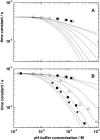Proton transfer dynamics at the membrane/water interface: dependence on the fixed and mobile pH buffers, on the size and form of membrane particles, and on the interfacial potential barrier
- PMID: 14747306
- PMCID: PMC1303918
- DOI: 10.1016/S0006-3495(04)74146-6
Proton transfer dynamics at the membrane/water interface: dependence on the fixed and mobile pH buffers, on the size and form of membrane particles, and on the interfacial potential barrier
Abstract
Crossing the membrane/water interface is an indispensable step in the transmembrane proton transfer. Elsewhere we have shown that the low dielectric permittivity of the surface water gives rise to a potential barrier for ions, so that the surface pH can deviate from that in the bulk water at steady operation of proton pumps. Here we addressed the retardation in the pulsed proton transfer across the interface as observed when light-triggered membrane proton pumps ejected or captured protons. By solving the system of diffusion equations we analyzed how the proton relaxation depends on the concentration of mobile pH buffers, on the surface buffer capacity, on the form and size of membrane particles, and on the height of the potential barrier. The fit of experimental data on proton relaxation in chromatophore vesicles from phototropic bacteria and in bacteriorhodopsin-containing membranes yielded estimates for the interfacial potential barrier for H(+)/OH(-) ions of approximately 120 meV. We analyzed published data on the acceleration of proton equilibration by anionic pH buffers and found that the height of the interfacial barrier correlated with their electric charge ranging from 90 to 120 meV for the singly charged species to >360 meV for the tetra-charged pyranine.
Figures







Similar articles
-
Low dielectric permittivity of water at the membrane interface: effect on the energy coupling mechanism in biological membranes.Biophys J. 2003 Aug;85(2):1307-16. doi: 10.1016/S0006-3495(03)74565-2. Biophys J. 2003. PMID: 12885673 Free PMC article.
-
Protons @ interfaces: implications for biological energy conversion.Biochim Biophys Acta. 2006 Aug;1757(8):913-30. doi: 10.1016/j.bbabio.2006.02.015. Epub 2006 Mar 24. Biochim Biophys Acta. 2006. PMID: 16624250 Review.
-
Probing biological interfaces by tracing proton passage across them.Photochem Photobiol Sci. 2006 Jun;5(6):577-87. doi: 10.1039/b516443e. Epub 2006 Apr 28. Photochem Photobiol Sci. 2006. PMID: 16761086
-
Influence of the membrane potential on the protonation of bacteriorhodopsin: insights from electrostatic calculations into the regulation of proton pumping.J Am Chem Soc. 2006 Sep 20;128(37):12129-39. doi: 10.1021/ja0619657. J Am Chem Soc. 2006. PMID: 16967962
-
Proton transfer dynamics at membrane/water interface and mechanism of biological energy conversion.Biochemistry (Mosc). 2005 Feb;70(2):251-6. doi: 10.1007/s10541-005-0108-1. Biochemistry (Mosc). 2005. PMID: 15807666 Review.
Cited by
-
Mechanism of long-range proton translocation along biological membranes.FEBS Lett. 2013 Feb 14;587(4):345-9. doi: 10.1016/j.febslet.2012.12.010. Epub 2012 Dec 22. FEBS Lett. 2013. PMID: 23268201 Free PMC article.
-
Protons, proteins and ATP.Photosynth Res. 2004;80(1-3):197-221. doi: 10.1023/B:PRES.0000030677.98474.74. Photosynth Res. 2004. PMID: 16328822
-
Microinjection in combination with microfluorimetry to study proton diffusion along phospholipid membranes.Eur Biophys J. 2008 Jul;37(6):865-70. doi: 10.1007/s00249-008-0295-y. Epub 2008 Mar 11. Eur Biophys J. 2008. PMID: 18330554
-
Theoretical evaluation of a possible nature of the outer membrane potential of mitochondria.Eur Biophys J. 2006 Dec;36(1):57-66. doi: 10.1007/s00249-006-0101-7. Epub 2006 Oct 5. Eur Biophys J. 2006. PMID: 17021806
-
Kinetic coupling of the respiratory chain with ATP synthase, but not proton gradients, drives ATP production in cristae membranes.Proc Natl Acad Sci U S A. 2020 Feb 4;117(5):2412-2421. doi: 10.1073/pnas.1917968117. Epub 2020 Jan 21. Proc Natl Acad Sci U S A. 2020. PMID: 31964824 Free PMC article.
References
-
- Arata, H., I. Takenaka, and M. Nishimura. 1987. Flash-induced proton release in Rhodopseudomonas sphaeroides spaeroplasts. J. Biochem. 101:261–265. - PubMed
-
- Baur, J. E., and R. M. Wightman. 1991. Diffusion-coefficients determined with microelectrodes. J. Electroanal. Chem. 305:73–81.
-
- Bell, R. P. 1973. The Proton in Chemistry. Chapman & Hall, London, UK.
-
- Berry, R. S., S. A. Rice, and J. Ross. 1980. Physical Chemistry. Wiley, New York.
Publication types
MeSH terms
Substances
LinkOut - more resources
Full Text Sources

